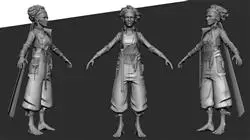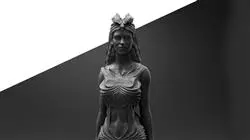University certificate
The world's largest faculty of information technology”
Introduction to the Program
If you want to understand the intrinsic keys to Digital Sculpture, this fully online training will take you on a tour of the fundamentals”

Digital design is a discipline that extends and has the capacity to influence other multiple areas such as industrial production, three-dimensional design and printing, animation or video game development, etc. Digital Sculpture is part of each of these areas, allowing the recreation of large spaces, infrastructures, objects and characters for virtual or physical use. The popularization of this area has also produced the need for specialized experts and professionals.
This Professional master’s degree in Digital Sculpture delves into issues such as the improvement and painting of meshes, the creation of three-dimensional machines according to their motility, character rigging, human and animal anatomy, software such as Blender, Arnold, Photoshop or ZBrush, and modeling with light, among many others.
It emphasizes the notions of topology at all levels of development and production of a model, as well as human and animal anatomy, in order to apply it later to modeling, texturing, lighting and rendering processes accurately. It also seeks to meet the demand for the creation of hair and clothing for video games, animation or 3D printing. Handling of modeling systems and knowledge of current industry systems.
Thanks to a totally online format, the deepening of knowledge in Digital Sculpture is combined with other personal and professional projects. The virtual platform, where teachers will post all the multimedia material and pedagogical resources so that students can progress at their own speed and pace, can be accessed at any time. All this will be taught with Relearning methodology, which promotes autonomous and practical learning for the student.
Learn independently all the keys in the process of creating Digital Sculpture and apply it to the design field you need”
This Professional master’s degree in Digital Sculpture contains the most complete and up-to-date scientific program on the market. The most important features include:
- The development of case studies presented by experts in 3D Modeling and Digital Sculpture
- The graphic, schematic, and eminently practical contents with which they are created, provide scientific and practical information on the disciplines that are essential for professional practice
- Practical exercises where the self-assessment process can be carried out to improve learning
- Its special emphasis on innovative methodologies
- Theoretical lessons, questions to the expert, debate forums on controversial topics, and individual reflection assignments
- Access to content from any fixed or portable device with an Internet connection
Accept new professional challenges, become skilled in Digital Sculpting and use it in any field of application be it 3D printing, design or production”
The program’s teaching staff includes professionals from sector who contribute their work experience to this training program, as well as renowned specialists from leading societies and prestigious universities.
The multimedia content, developed with the latest educational technology, will provide the professional with situated and contextual learning, i.e., a simulated environment that will provide immersive training programmed to train in real situations.
This program is designed around Problem-Based Learning, whereby the professional must try to solve the different professional practice situations that arise during the academic year. For this purpose, the student will be assisted by an innovative interactive video system created by renowned and experienced experts.
With this online degree you will be able to highlight your CV and make it more attractive than others in the same sector, give a twist to your career”

A Professional master’s degree in Digital Sculpture, fully online and guided by a faculty made up of experts of the highest prestige in the field”
Why study at TECH?
TECH is the world’s largest online university. With an impressive catalog of more than 14,000 university programs available in 11 languages, it is positioned as a leader in employability, with a 99% job placement rate. In addition, it relies on an enormous faculty of more than 6,000 professors of the highest international renown.

Study at the world's largest online university and guarantee your professional success. The future starts at TECH”
The world’s best online university according to FORBES
The prestigious Forbes magazine, specialized in business and finance, has highlighted TECH as “the world's best online university” This is what they have recently stated in an article in their digital edition in which they echo the success story of this institution, “thanks to the academic offer it provides, the selection of its teaching staff, and an innovative learning method aimed at educating the professionals of the future”
A revolutionary study method, a cutting-edge faculty and a practical focus: the key to TECH's success.
The most complete study plans on the university scene
TECH offers the most complete study plans on the university scene, with syllabuses that cover fundamental concepts and, at the same time, the main scientific advances in their specific scientific areas. In addition, these programs are continuously being updated to guarantee students the academic vanguard and the most in-demand professional skills. In this way, the university's qualifications provide its graduates with a significant advantage to propel their careers to success.
TECH offers the most comprehensive and intensive study plans on the current university scene.
A world-class teaching staff
TECH's teaching staff is made up of more than 6,000 professors with the highest international recognition. Professors, researchers and top executives of multinational companies, including Isaiah Covington, performance coach of the Boston Celtics; Magda Romanska, principal investigator at Harvard MetaLAB; Ignacio Wistumba, chairman of the department of translational molecular pathology at MD Anderson Cancer Center; and D.W. Pine, creative director of TIME magazine, among others.
Internationally renowned experts, specialized in different branches of Health, Technology, Communication and Business, form part of the TECH faculty.
A unique learning method
TECH is the first university to use Relearning in all its programs. It is the best online learning methodology, accredited with international teaching quality certifications, provided by prestigious educational agencies. In addition, this disruptive educational model is complemented with the “Case Method”, thereby setting up a unique online teaching strategy. Innovative teaching resources are also implemented, including detailed videos, infographics and interactive summaries.
TECH combines Relearning and the Case Method in all its university programs to guarantee excellent theoretical and practical learning, studying whenever and wherever you want.
The world's largest online university
TECH is the world’s largest online university. We are the largest educational institution, with the best and widest online educational catalog, one hundred percent online and covering the vast majority of areas of knowledge. We offer a large selection of our own degrees and accredited online undergraduate and postgraduate degrees. In total, more than 14,000 university degrees, in eleven different languages, make us the largest educational largest in the world.
TECH has the world's most extensive catalog of academic and official programs, available in more than 11 languages.
Google Premier Partner
The American technology giant has awarded TECH the Google Google Premier Partner badge. This award, which is only available to 3% of the world's companies, highlights the efficient, flexible and tailored experience that this university provides to students. The recognition as a Google Premier Partner not only accredits the maximum rigor, performance and investment in TECH's digital infrastructures, but also places this university as one of the world's leading technology companies.
Google has positioned TECH in the top 3% of the world's most important technology companies by awarding it its Google Premier Partner badge.
The official online university of the NBA
TECH is the official online university of the NBA. Thanks to our agreement with the biggest league in basketball, we offer our students exclusive university programs, as well as a wide variety of educational resources focused on the business of the league and other areas of the sports industry. Each program is made up of a uniquely designed syllabus and features exceptional guest hosts: professionals with a distinguished sports background who will offer their expertise on the most relevant topics.
TECH has been selected by the NBA, the world's top basketball league, as its official online university.
The top-rated university by its students
Students have positioned TECH as the world's top-rated university on the main review websites, with a highest rating of 4.9 out of 5, obtained from more than 1,000 reviews. These results consolidate TECH as the benchmark university institution at an international level, reflecting the excellence and positive impact of its educational model.” reflecting the excellence and positive impact of its educational model.”
TECH is the world’s top-rated university by its students.
Leaders in employability
TECH has managed to become the leading university in employability. 99% of its students obtain jobs in the academic field they have studied, within one year of completing any of the university's programs. A similar number achieve immediate career enhancement. All this thanks to a study methodology that bases its effectiveness on the acquisition of practical skills, which are absolutely necessary for professional development.
99% of TECH graduates find a job within a year of completing their studies.
Professional Master's Degree in Digital Sculpture
.
The growing expansion of the video game industry in recent times has generated the need for expert and highly specialized professionals in various areas. Among them, Digital Sculpting stands as one of the most important, since it is responsible for performing the 3D modeling of objects, characters, scenarios and machines, resulting elementary in the creation of video games with three-dimensional graphics. And in it you can update with all the guarantees thanks to the Professional Master's Degree in Digital Sculpting.
Professional Master's Degree with TECH the 3D Design applied to Lettering
.
With the aim of preparing you to meet the present and future challenges of the sector, this Professional Master's Degree in Digital Sculpture will enhance your skills thanks to dynamic teaching resources. Thus, the title addresses a wide variety of topics, such as 3D Design applied to Lettering, the Baked of organic textures, the management of Software such as Blender, Unity or Marmoset or the organic modeling of nature and terrain, among other topics. But the best thing is that this Professional Master's Degree is taught exclusively online, so you can manage your own academic time. In this way, it is a program highly compatible with your personal and professional activities.







